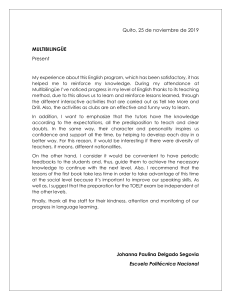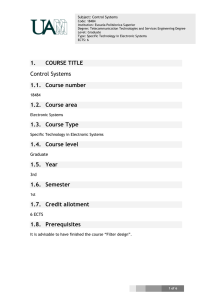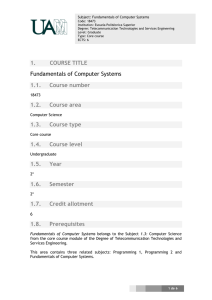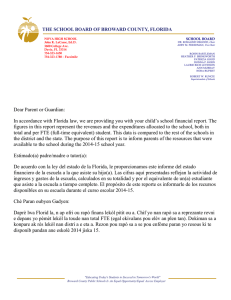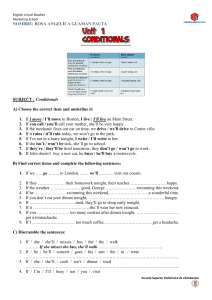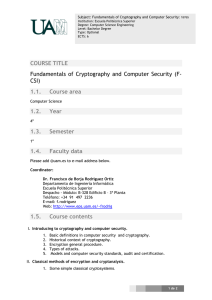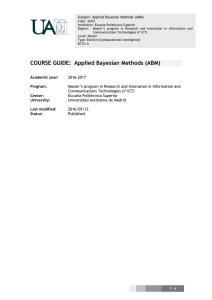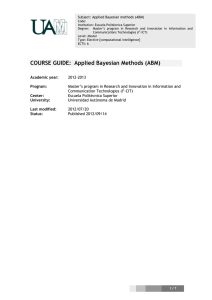1. COURSE TITLE Discrete Structures and Logic 1.1. Course
Anuncio
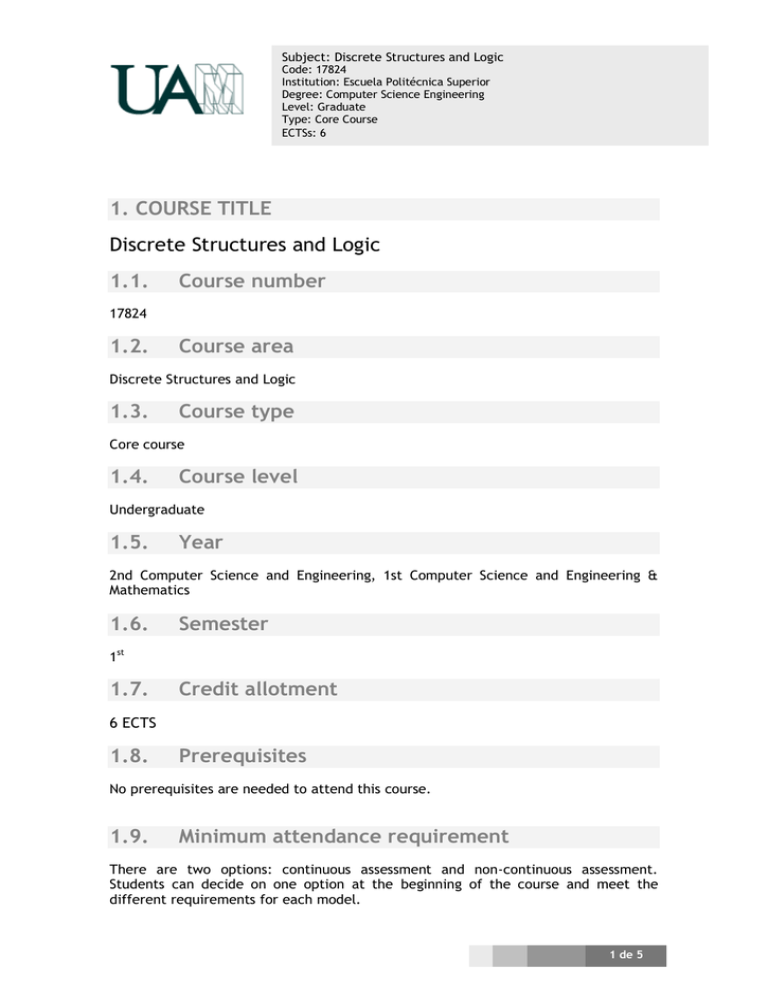
Subject: Discrete Structures and Logic Code: 17824 Institution: Escuela Politécnica Superior Degree: Computer Science Engineering Level: Graduate Type: Core Course ECTSs: 6 1. COURSE TITLE Discrete Structures and Logic 1.1. Course number 17824 1.2. Course area Discrete Structures and Logic 1.3. Course type Core course 1.4. Course level Undergraduate 1.5. Year 2nd Computer Science and Engineering, 1st Computer Science and Engineering & Mathematics 1.6. Semester 1st 1.7. Credit allotment 6 ECTS 1.8. Prerequisites No prerequisites are needed to attend this course. 1.9. Minimum attendance requirement There are two options: continuous assessment and non-continuous assessment. Students can decide on one option at the beginning of the course and meet the different requirements for each model. 1 de 5 Subject: Discrete Structures and Logic Code: 17824 Institution: Escuela Politécnica Superior Degree: Computer Science Engineering Level: Graduate Type: Core Course ECTSs: 6 CONTINUOUS ASSESSMENT METHOD WITH MANDATORY CLASS ATTENDANCE Attendance of at least 85% of lectures is mandatory. NON-CONTINUOUS ASSESSMENT METHOD WITHOUT MANDATORY CLASS ATTENDANCE Attendance to the lectures is recommended, but not mandatory. 1.10. Faculty data Add @uam.es to all email addresses below. Dr. Pilar Rodríguez Marín Computer Science Department Escuela Politécnica Superior Office: B-326 Tel.: +34 914972283 e-mail: pilar.rodriguez Dr. Luis Lago Fernández Computer Science Department Escuela Politécnica Superior Office: B-307 Tel.: +34 914972211 e-amil: luis.lago http://www.eps.uam.es/~lflago/ Dr. Alberto Suárez González (Coordinator) Computer Science Department Escuela Politécnica Superior Office: B-309 Tel.: +34 914972286 e-mail: [email protected] http://www.eps.uam.es/~asuarez 1.11. Course objectives B3: Basic concepts about discrete mathematics, logic, algorithm and computational complexity theory, as well as their application to the resolution of engineering problems. Specific objectives of this subject are: 2 de 5 Subject: Discrete Structures and Logic Code: 17824 Institution: Escuela Politécnica Superior Degree: Computer Science Engineering Level: Graduate Type: Core Course ECTSs: 6 UNIT BY UNIT SPECIFIC OBJECTIVES TEMA 1.- Introduction to propositional and predicate logics Know how to define and use the basic elements in propositional logic. Interpretation of well-formed formulas (wff) in propositional logic. Representation of knowledge 1.1. bases written in natural language as well-formed formulas (wff) in propositional logic. Be able to understand a logic deduction. Be able to carry out a simple deduction in propositional logic. Conversion of wffs to equivalent normal forms. Understand the relationship between formal reasoning and natural deduction. Know how to use truth tables to determine whether a wff is a logic consequence of a 1.2. knowledge base. Demonstration by Inference: deduction, proof by contradiction. Resolution. Know how to define and use the basic elements in predicate logic. Interpretation of 1.3. well-formed formulas (wff) in predicate logic. Representation of knowledge bases written in natural language as well-formed formulas (wff) in predicate logic. TEMA 2.- Enumeration and combinatory 2.1. Rules of sum and product. 2.2. Permutation definition and calculus. 2.3. Combination definition and calculus. 2.4. Combinatorial numbers. Binomial theorem. 2.5. Combinations with repetition. TEMA 3.1. 3.2. 3.3. 3.4. 3.5. 3.6. 3.- Graphs Graphs. Types of graphs. Paths. Vertex degree. Distance between two vertices. Matrix representations of graphs. Eulerian graphs and associated algorithms. Hamiltonian graphs and associated algorithms. Algorithms to determine the shortest path in a graph. TEMA 4.- Trees 4.1. Basic concepts about trees. 4.2. Minimum spanning trees. TEMA 5.1. 5.2. 5.3. 5.4. 5.5. 5.- Computation Models and Turing Machines (TM) Different computational models. Analysis and design of simple finite automata. TM definition. Analysis of simple TM. Church-Turing Thesis. Universal TM. Proof of the halting problem 3 de 5 Subject: Discrete Structures and Logic Code: 17824 Institution: Escuela Politécnica Superior Degree: Computer Science Engineering Level: Graduate Type: Core Course ECTSs: 6 1.12. Course contents 1. Introduction to Propositional and Predicate Logic 1.1. Propositional logic 1.1.1. Knowledge representation, reasoning and logic. 1.1.2. Syntax: Atoms, logic connectors, well-formed formulas. 1.1.3. Semantics: Truth tables and interpretation. 1.1.4. Equivalence rules. 1.1.5. Logic satisfiability. 1.1.6. Reasoning using truth tables. 1.2. Inference 1.2.1. Inference rules in propositional logic. 1.2.2. Reasoning by inference: theorems, proofs. 1.2.3. Correction and completeness. 1.2.4. Proof by inference: Deduction and contradiction. 1.2.5. Normal forms. 1.2.6. Resolution. 1.3. Predicate Logic 1.3.1. Higher-order logics 1.3.2. Predicate logic: syntax and semantics. 1.3.3. Functions and predicates. 1.3.4. Variables and quantifiers. 1.3.5. Equivalence rules. 1.3.6. Inference rules. 1.3.7. Knowledge representation in predicate logic. 1.3.8. Ontologies 2. Enumeration and Combinatory. 2.1. 2.2. 2.3. 2.4. 2.5. Rules of sum and product. Pigeonhole principle. Permutations and combinations. Binomial coefficients. Permutations and combinations with repetitions 3. Graphs. 3.1. 3.2. 3.3. 3.4. 3.5. 3.6. Basic definitions. Graph representation. Graph isomorphism. Paths, cycles and connectivity. Eulerian and Hamiltonian paths. Shortest paths. Graph algorithms. 4. Trees. 4.1. 4.2. 4.3. 4.4. 4.5. Basic definitions. Tree applications. Spanning trees. Minimum spanning tree. Tree algorithms. 4 de 5 Subject: Discrete Structures and Logic Code: 17824 Institution: Escuela Politécnica Superior Degree: Computer Science Engineering Level: Graduate Type: Core Course ECTSs: 6 5. Models of computation and Turing machines 5.1. 5.2. 5.3. 5.4. 5.5. Models of computation. Finite automata and formal languages. Turing Machine. Church-Turing thesis. Universal Turing Machine. The halting problem. 1.13. Course bibliography 1. [ENG] Discrete Mathematics and its Applications, K.H. Rosen, Ed. McGraw Hill, 2004. [ESP] Matemática Discreta, K.H. Rosen, Ed. McGraw Hill, 2004. 2. [ENG] Discrete and Combinatorial Mathematics An Applied Introduction, Ralph P. Grimaldi, Pearson, 2004. [ESP] Matemáticas Discretas y Combinatoria (3ª Ed.), Ralph P. Grimaldi, Ed. Prentice May, 1998. 3. Matemáticas Discretas, T. Veerarajan, Ed. McGraw Hill, 2008. 4. Nilsson, N.J.: "Artificial Intelligence, a new synthesis", Ed. Morgan Kaufmann Publishers, 1998 5. [ENG] Feynman lectures on computation, Richard P. Feynman, AddisonWesley, 1996. [ESP] Conferencias sobre computación, Richard P. Feynman, Ed. Drakontos clásicos, 2003. 6. Introducción a la lógica formal, Alfredo Deaño, Alianza Editorial, 2004. 7. Lógica computacional, Enrique Paniagua Arís et al., Ed. Thomson, 2003. 8. Elementos de lógica formal, Calixto Badesa et al., Ed. Ariel, 2003. 9. Artificial Intelligence: a modern approach, S. Russell y P. Norvig, Ed. Prentice Hall, 1995. 10. An introduction to algorithms, T.H. Cormen,The MIT Press (2009) 5 de 5
